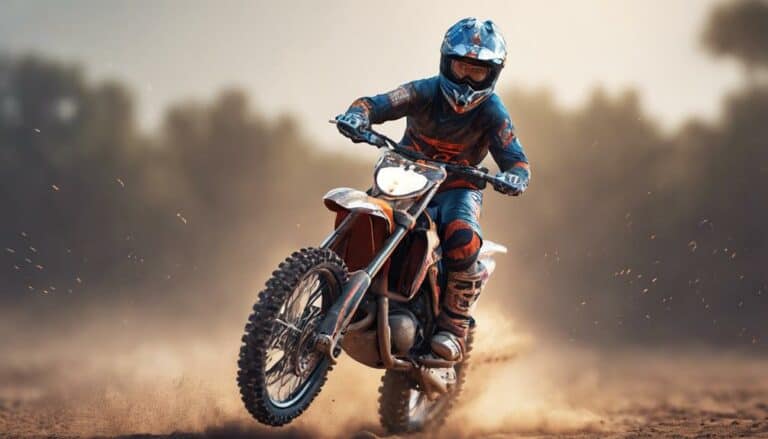When gearing up for that exhilarating jump on your dirt bike, throttle control emerges as the unsung hero in determining your success. Visualize this: the thrill of the jump, the rush of the wind, but your throttle control can make or break your landing.
How you manipulate that throttle can be the difference between a smooth flight and a bumpy touchdown. So, let's explore just how pivotal throttle control is in mastering those gravity-defying leaps on your trusty dirt bike.
Key Takeaways
- Throttle control is crucial for stability, speed, and trajectory in jumps.
- Smooth throttle application prevents nosedives and ensures controlled landings.
- Proper throttle management influences jump distance and landing angle.
- Consistent and gradual throttle inputs are key to mastering dirt bike jumps.
Importance of Throttle Control in Jumping
In mastering the art of jumping a dirt bike, understanding the paramount importance of throttle control is essential for achieving stability and precision in your jumps. Throttle control is the key to unleashing the perfect balance between speed, lift, and trajectory as you soar through the air. By manipulating the throttle with finesse, you can control the bike's movements with precision, ensuring a smooth takeoff, mid-air stability, and a safe landing.
Proper throttle management isn't just about going fast; it's about finding the right amount of power to propel you into the air while maintaining stability. Adjusting the throttle input can dictate the bike's pitch and landing angle, critical factors in determining the success of your jump. Smooth and deliberate throttle control before, during, and after takeoff is the cornerstone of consistent and controlled jumps. Any mistakes in throttle control, such as sudden changes or over-revving, can lead to instability and unsafe landings. Mastering throttle control is the gateway to unleashing the full potential of your dirt bike jumps.
Tips for Mastering Throttle Control
To enhance your dirt bike jumping skills, mastering throttle control is key to achieving stability and precision in your jumps. When it comes to throttle control, remember that smooth throttle application is critical.
Before hitting the jump, roll off the throttle slightly to prevent nosediving and guarantee a more stable takeoff. Once airborne, tapping the throttle lightly can help level the bike and adjust your trajectory for a smoother landing.
Experiment with your throttle positioning – being far forward or far back – to see how it affects your jumps. For beginners, focusing on gradual throttle inputs can greatly improve your jump execution and overall control.
Common Throttle Control Mistakes to Avoid
One critical throttle control mistake to avoid when jumping a dirt bike is abruptly chopping the throttle on the lip, as it can result in dangerous nosedives. To jump your dirt bike successfully, keep these tips in mind:
- Maintain Control: Rolling off the throttle while airborne helps you stay in control and prevents over-revving, ensuring a smoother landing.
- Achieve Desired Trajectory: Proper throttle management is vital for determining your jump trajectory. Adjust the throttle to control the bike's flight path.
- Land Safely: Smooth throttle control plays a significant role in landing safely after a jump. Gradually adjust the throttle to cushion your landing.
- Prevent Mistakes: Utilizing smooth and consistent throttle control throughout the jump is key to avoiding mistakes and ensuring a successful jump.
How Throttle Control Affects Jump Distance
When considering how throttle control affects jump distance on a dirt bike, mastering the nuances of throttle input is paramount for achieving ideal trajectory and coverage. The amount of throttle applied directly influences the speed at which the bike approaches the jump, impacting the distance it can cover.
By managing the throttle properly, riders can guarantee they clear jumps with the right trajectory and distance. Adjusting throttle input while airborne also plays an essential role in controlling the bike's rotation and influencing the landing distance.
Consistent throttle control throughout the jump is essential to prevent the bike from losing momentum mid-flight, which could affect the overall jump distance. Further, the timing of throttle application, both before and during the jump, plays a key role in determining the distance covered, making it a key factor in achieving successful jumps.
Using Throttle Control for Smooth Landings
Efficient throttle control plays an important role in ensuring smooth and stable landings when jumping a dirt bike. When utilizing throttle control for smooth landings, consider the following:
- Trajectory Adjustment: Modulating the throttle can help adjust the bike's trajectory mid-air, aligning it for a smoother descent upon landing.
- Landing Stability: Proper throttle management while airborne can prevent abrupt nosedives, contributing to improved stability upon landing.
- Throttle Management: Maintaining a consistent throttle input during the descent phase aids in controlling the bike's pitch and roll, ensuring a more controlled landing.
- Impact Absorption: Smoothly rolling off the throttle just before landing allows the suspension to absorb the impact gradually, reducing the chances of losing control.
Conclusion
Now that you understand the significance of throttle control in dirt bike jumping, remember this: mastering throttle management is like walking a tightrope – one wrong move can throw you off balance.
Practice diligently, adjust your inputs with precision, and soon you'll be soaring through the air with grace and control. Keep honing your skills, and before you know it, you'll be executing jumps with the finesse of a seasoned pro.
Stay focused, stay determined, and keep pushing your limits.

